英国法国语言政策笔记
【第二外语】大学二外 法语French语法 学习笔记
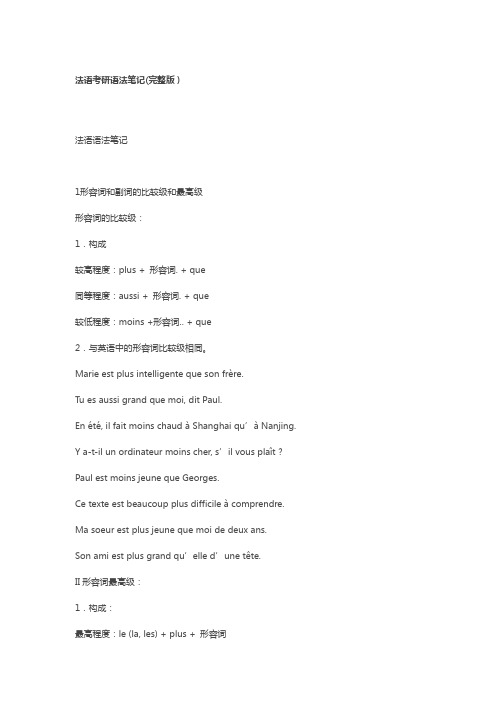
法语考研语法笔记(完整版)法语语法笔记1形容词和副词的比较级和最高级形容词的比较级:1.构成较高程度:plus + 形容词. + que同等程度:aussi + 形容词. + que较低程度:moins +形容词.. + que2.与英语中的形容词比较级相同。
Marie est plus intelligente que son frère.Tu es aussi grand que moi, dit Paul.En été, il fait moins chaud à Shanghai qu’à Nanjing. Y a-t-il un ordinateur moins cher, s’il vous plaît ? Paul est moins jeune que Georges.Ce texte est beaucoup plus difficile à comprendre. Ma soeur est plus jeune que moi de deux ans.Son ami est plus grand qu’elle d’une tête.II形容词最高级:1.构成:最高程度:le (la, les) + plus + 形容词最低程度:le (la, les) + moins + 形容词2.用法:与英语中的形容词最高级相同,但定冠词要与有关形容词的性、数一致,最高级的补语(即比较范围),通常由介词de引导。
Paris est la plus belle ville de France, je crois.Ces deux chambres sont les moins grandes de l’hôtel.形容词的最高级有时放在名词后面,重复定冠词:Paris est la ville la plus belle de France.Voilà les romans les plus intéressants de notre bibliothèque.Dupont est un de mes plus vieux amis.Shanghai est un des ports les plus importants de Chine.III几个特殊词形的形容词比较级和最高级Bon(ne)(s)(nes) Meilleur(e)(s)(es) Le/la/les meilleurMauvais(e)(es) Pire(s)plus mauvais Le/la/les pire(s)Le/la/les plus mauvaisPetit(e)(s)(es) moindreplus petit le moindrele plus petitLa plaisanterie la plus courte est souvent la meilleure.Ce manuel est pire (plus mauvais) que l’autre.C’est la pire (la plus mauvaise) composition de la classe.Elle est la plus petite de la famille.Moindre/le moindre 一般用于抽象名词Je n’ai pas la moindre idée de cela副词的比较级1.构成:较高程度:plus + adv. + que同等程度:aussi + adv. + que较低程度:moins + adv. + que2.用法:与英文中的副词比较级类似Paulette va au théâtre plus souvent que sa soe ur.Je parle français aussi bien que lui.Tiens! ta fille écrit plus vite qu’avant.Il pleut moins souvent à Nice qu’à Paris.Au centre de la ville, on se gare moins facilement.比较级中有时可加入一个表示程度差异的其他成分:Pierre court beaucoup moins vite que ses camarades.Le guide est arrivé à l’hôtel une heure plus tôt que les voyage urs.II副词的最高级1.构成:最高程度:le + plus + adv.最低程度:le + moins + adv.副词最高级只能用« le »2.用法:与英语的副词最高级相同,但补语一般由介词de引导Mme Dupont va au supermarché le plus souvent de tous les habitants du quatier.Viens le plus souvent possible.Viens le plus souvent que tu pourras.III几个特殊词形的副词比较级和最高级bien mieux le mieuxbeaucoup plus le pluspeu moins le moinsMon amie parle anglais mieux que moi, parce qu’elle lit plus.La raison en est simple : tu travailles moins bien, donc tu gagnes moins ; il travaille le mieux, il gagne le plus.表示数量的副词beaucoup,其表示同等级的比较级是autant(as much as, as many as)Je crois qu’elle lit autant que moi.Beaucoup de, peu de 也可以有比较级和最高级:Il y a plus de clients au supermarché que chez les petits commerçants.Tu vois, j’ai acheté autant de livres que toi.Elles ont moins de temps pour faire leurs courses.Nicolas fait le plus de fautes dans sa dictée.C’est lui qui a le moins de capacité pour ce travail.2关系代词qui/que/où/dontQUI=SUJET QUE=C O D OU=时间地点DONT=在DE之后关系代词qui1.Qui在从句中作主语,先行词可以是人也可以是物,相当于英语中的who, which, that. Les jeunes gens qui travaillet à l’usine ont acheté d’abord un téléviseur, ensuiteune voiture.2.Qui在从句中与介词一起使用,可作间接宾语或状语。
二外三级基础法语语法笔记 整理版
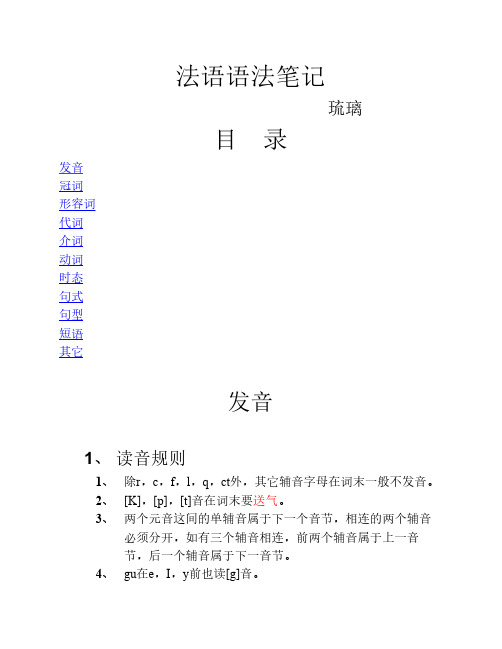
单数
复数
第一人称
Me
Nous
第二人称
Te
Vous
第三
阳性
Se
Se
人称
自反代词是一种宾语人称代词。在句中的位置和其它宾语人称代词 一样,一般均放在有关动词前面。只有在肯定命令式中置于谓语的后
面。 注意:在命令式的第一、二人称单数时,要将me和te改成moi和toi并
不要忘记连字符。
7. 中性代词le
4、 特殊情况
1、 在主谓颠倒的疑问结构中,如果谓语的最后一个字母是元 音,而所用的人称代词亦是元音开头时,那么为了发音的关 系,须在两者之间加上“t”。如:Ou va-t-elle?
2、 Ai-je vu? 句中,ai-je的发音应为[ε:З]。 3、 Plus的发音较复杂,总的来说有以下几个规律:
1、 不定冠词、定冠词
阳性
阴性
不定冠词 定冠词
单数 复数 单数 复数
un
Une
des
Le / l’
La / l’
les
注意:1、aimer、préfer的名词宾语要用定冠词。 2、如果不定冠词des后面紧跟一个形容词(或一个修饰形容词 的副词),应把des改为介词de
Tu as fait des progrès. - Tu as fait de grands progrès.
2、 省音
少数以元音字母结尾的单音节词,常和下一词的词首元音合读成一 个音节,而省去词末的元音字母。
Ce,se,que,je,te,me,le,ne,,la,de,,,,,,
3、 连音、联诵
连音
代词主语后面的动词如果是以元音或哑间“h”开始,那么它们必须连 音。如果主语不是代词,则不能连音。
法国语言与文化 之 政治 部分

20:08:35
20:08:35
20:08:35
法兰西第五共和国的政治
20:08:35
政 治 制 度
政 治 领 袖 政 治 事 件 外 交 关 系 生 活 常 识
20:08:35
政治制度
法国是典型的半总统制半议会制的民主共和制的国 家,国家政权带有鲜明的阶级性。 现行第五共和国宪法(1958年9月公民投票通过,10 月4日生效,是法国历史上第16部宪法,曾进行过多次 修改)规定:总统是国家元首和武装部队统帅,任期5 年,由选民直接选举产生,直接对选民负责而不对议会 负责。政府由总统任命。总统有权任免总理和批准总理 提名的各部长;主持部长会议、国防会议和外交事务的 决策权;有权以任何原因解散议会,但一年内不得两次 解散;可绕过议会将重要法案直接提交公民投票表决。 在非常时期,总统拥有“根据形势需要采取必要措施” 的全权。没有副总统,在总统不能履行职务或空缺时, 由参议院议长代行总统职权。 20:08:35
20:08:35
法国的司法体系
法国现行的法律制度是大陆法律体系,即成文法。 该法律体系是自 1785 年以来,法国至今沿用的法律 制度,有着悠久的司法文明历史。该法律制度是法 国革命的产物,也是西方社会奉行的“立法、行政、 司法”三权分立的典范。两次世界大战期间,法国 连续遭到三次经济危机的袭击,国内阶级矛盾空前 尖锐、复杂。为了应付紧急形势,削弱了议会权力, 加强了行政权力,政府的委托立法议案在议会中占 据优势。同时为缓和人民群众强烈的民主运动,于 1919年4月和1927年7月,进行了两次选举制度的改 革,对原来的法典进行某些修改与补充,判例作用 有所提高,二战后法国先后制定了 1946 年第四共和 国宪法和1958年第五共和国宪法。
语言学笔记1

笔记 1.10.What functions does language have?Language has at least seven functions: phatic, directive, Informative, interrogative, expressive, evocative and per formative. According to Wang Gang (1988,p.11), language has three main functions: a tool of communication, a tool whereby people learn about the world, and a tool by which people learn about the world, and a tool by which people create art. M .A. K.Halliday, representative of the London school, recognizes three “Macro-Functions”: ideational, interpersonal and textual (see! 11-17;see HU Zhuanglin et al., pp10-13, pp394-396).1.20.What are the major branches of linguistics?The study of language as a whole is often called general linguistics (e.g.Hu Zhuanglin et al., 1988;Wang Gang, 1988). But a linguist sometimes is able to deal with only one aspect of language at a time, thus the arise of various branches: phonetics, phonology, morphology, syntax, semantics, sociolinguistics, applied linguistics, pragmatics, psycholinguistics, lexicology, lexicography, etymology, etc.1.1. What is language?“Language is system of arbitrary vocal symbols used for human communication. It is a system, since linguistic elements are arranged systematically, rather than randomly. Arbitrary, in the sense that there is usually no intrinsic connection between a work (like “book”) and the object it refers to. This explains and is explained by the fact that different languages have different “books”: “book” in English, “livre” in French, in Japanese, in Chinese, “check” in Korean. It is symbolic, because words are associated with objects, actions, ideas etc. by nothing but convention. Namely, people use the sounds or vocal forms to symbolize what they wish to refer to. It is vocal, because sound or speech is the primary medium for all human languages, developed or “new”. Writing systems came much later than the spoken forms. The fact that small children learn and can only learn to speak (and listen) before they write (and read) also indicates that language is primarily vocal, r ather than written. The term “human” in the definition is meant to specify that language is human specific.1.2. What are design features of language?“Design features” here refer to the defining properties of human language that tell the difference between human language and any system of animal communication. They are arbitrariness, duality, productivity, displacement, cultural transmission and interchangeability1.69.What is Antonymy? How many kinds of antonyms are there?The term “antonymy” is us ed for oppositions of meaning; words that stand opposite in meaning are called “antonyms”, or opposites, which fall in there categories1)gradable antonyms(e.g, good-bad); (2)complementary antonyms(e.g., single-mar-ried); (3)relational antonyms(e.g., buy-sell).1.74.What is componential analysis?“Componential analysis” defines the meaning of a lexical element in terms of semantic components. For example, we may “clip” the following words “Man”, “Woman”, “Boy” and “Girl” so that we have only separate parts o f them.Man: +Human+Adult+MaleWoman:+Human+Adult-MaleBoy:+Human-Adult+MaleGirl:+Huamn-Adult-Male1.75.What is predication analysis? What is a one-place predicate? What is a two-place predicate? What is a no-place predicate? What are down-graded predications?“Predication analysis” is a new approach for sentential meaning analysis. “Predication” is usually considered an important common category shared by propositions, questions, commands, etc. Predication is to break down the sentence into their smaller constituents: argument (logical participant) and predicate (relation element). The “predicate” is the major or pivotal element governing the argument. We may now distinguish a “two-placepredicate” (which governs two arguments, e.g., subject and object), a“one-place predicate” (which governs one argument, i.e., subject) and a “no-place predicate” that has simply no argument(no real subject or object). immediate constituent analysis, also called Ic Analysis, in linguistics, a system of grammatical analysis that divides sentences into successive layers, or constituents, until, in the final layer, each constituent consists of only a word or meaningful part of a word. (A constituent is any word or construction that enters into some larger construction.) In the sentence “The old man ran away,” the first division into immediate constituents would be between “the old man” and “ran away.” The immediate constituents of “the old man” are “the” and “old man.” At the next level “old man” is divided into “old” and “man.” The term was introduced by the United States linguist Leonard Bloomfield in 1933, though the underlying principle is common both to the traditional practice of parsing and to many modern systems of grammatical analysis. “IC analysis” is a new approach of sentence study that cuts a sentence into two(or more) segments. This kind of pure segmentation is simply dividing a sentence into its constituent elements without even knowing what they really are . What remain of the first cut are called “immediate constituents”, and what are left at the final cut are cal led “ultimate constituents”. For example, “John left yesterday” can be thus segmented: “John| left | | yesterday”. We get two immediate constituents for the first cut (|), and they are “John” and “left yesterday”. Further split(||) this sentence generates three “ultimate constituents”: “John”, “left ” and “yesterday英语起源与发展的简短介绍英语真正的历史应该从公元5世纪时入侵英国的三个日耳曼部落说起. 这几个部落分别是:盎格鲁人,撒克逊人和朱特人,他们从今天的德国北部和丹麦出发,然后横渡北海。
法语有趣的知识点总结

法语有趣的知识点总结法语(français)是世界上最受欢迎的语言之一,也是联合国官方语言之一。
它在全球范围内有超过2.7亿的使用者,它是许多国际组织的官方语言,如欧盟、非洲联盟和国际红十字会。
法语在文学、音乐、电影、艺术和文化领域都有着丰富的历史和影响力。
1.法语的历史法语的历史可以追溯到中世纪的拉丁语。
在845年,“Straits of Verduen”签订后,法语才开始被正式记录下来。
法国的国家语言是法语,然而在法国的大部分地区,还使用各种地方方言。
直到16世纪,法国国王法兰西斯一世颁布了15世纪以来最重要的法国法典《法国法典》,这部法典被认为是法语写作的奠基之作。
2.法语的语音法语拥有许多特殊的语音和发音规则。
例如,法语有许多不发音的字母,导致了法语的写法和发音之间的不一致。
此外,法语的元音和辅音的组合也有特殊的发音规则,例如“oi”、“eu”、“ou”等。
最重要的是,法语的重音位置对于词义的区分有着至关重要的作用。
3.法语的语法法语的语法结构与英语有很大的差异。
例如,法语中的名词有性别之分,而且在单数和复数形式上有不同的变化。
此外,形容词和名词之间的关系也有着复杂的词序和变格规则。
法语的动词时态和语态也比较复杂,有15种不同的时态和语态形式。
4.法语的词汇法语的词汇来源广泛,涉及拉丁语、希腊语、西班牙语、德语和英语等。
法语中有许多与英语相似的词语,这使得学习法语对于英语母语者来说相对容易一些。
然而,法语中也有许多独特的词语,例如“deja vu”(已经看到)、“a la carte”(点菜)等。
5.法语的方言和地区差异法语的方言和地区差异非常明显。
在法国的不同地区,人们会使用不同的方言和口音。
例如,南部的普罗旺斯地区有着浓重的地方口音,而北部的法国人又有着完全不同的口音。
此外,在法国以外的地区,如比利时、卢森堡、瑞士和加拿大,也有着各自独特的法语口音和用法。
6.法语的文学和文化法语是世界上最重要的文学语言之一,法国有着诸多伟大的文学作品和作家,如雨果、莫泊桑、巴尔扎克等。
语言调查方法课程笔记
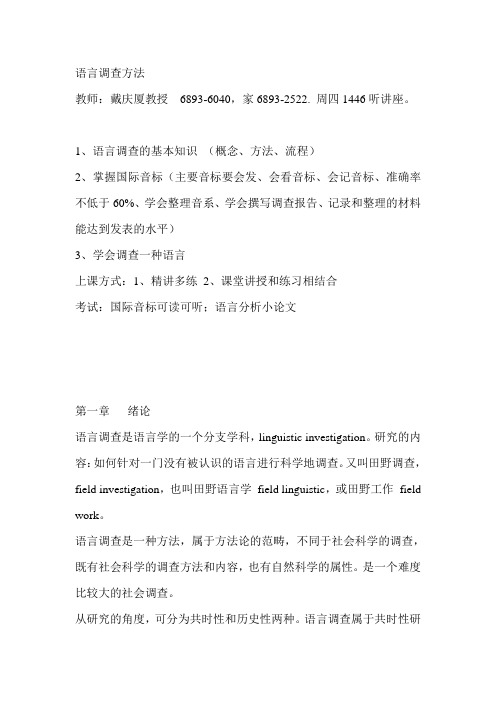
语言调查方法教师:戴庆厦教授6893-6040,家6893-2522. 周四1446听讲座。
1、语言调查的基本知识(概念、方法、流程)2、掌握国际音标(主要音标要会发、会看音标、会记音标、准确率不低于60%、学会整理音系、学会撰写调查报告、记录和整理的材料能达到发表的水平)3、学会调查一种语言上课方式:1、精讲多练2、课堂讲授和练习相结合考试:国际音标可读可听;语言分析小论文第一章绪论语言调查是语言学的一个分支学科,linguistic investigation。
研究的内容:如何针对一门没有被认识的语言进行科学地调查。
又叫田野调查,field investigation,也叫田野语言学field linguistic,或田野工作field work。
语言调查是一种方法,属于方法论的范畴,不同于社会科学的调查,既有社会科学的调查方法和内容,也有自然科学的属性。
是一个难度比较大的社会调查。
从研究的角度,可分为共时性和历史性两种。
语言调查属于共时性研究,是描写语言学范畴。
任务有二,一是科学的分析和描写语言的语音和词汇,寻求内部规律,二是科学地描写语言的社会功能,文化功能。
结构本身的调查和分析难度较大。
语言调查的基础,语言描写建立在语言现实的认识,而对语言现实的认识建立在语言调查的基础上。
意义:一、得到丰富的活的有用的语言调查,为语言研究提供可靠的研究素材。
克木语:有习惯音调,pat55,pam53.在老挝考察时,发现了很有价值的声调材料。
对研究声调起源很有启发。
清音高调Pat55浊音低调Bat33二、对于古历史文献的研究,语言调查更为重要。
是现状研究和历史研究的主要渠道。
三、要不断使用活的语言材料,更新语言学的研究。
离开活的语言事实,语言研究无法发展语言调查能够印证语言研究的结论。
四、对语言规范、新文字、方言人学习普通话、标准音的选择、编写教科书,已经现代化进程中,语言如何发展的问题都有重要的现实意义。
法国的语言政策
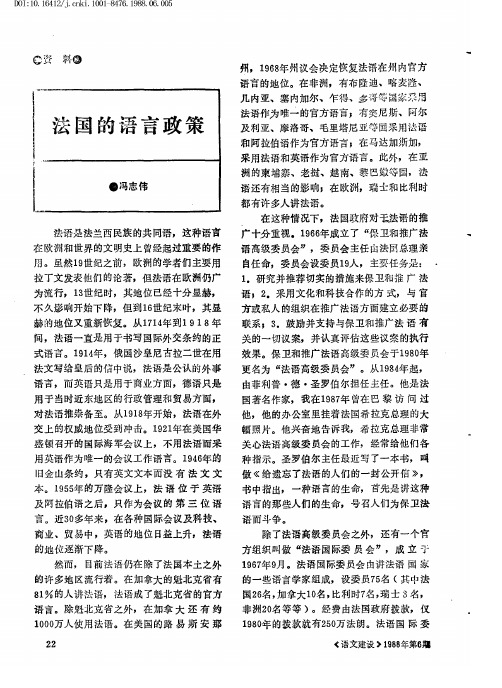
因 为 法 国 以 英语 为 第
语言 等 集
,
( 季刊 )
现代法语
。
要 劝 说其他 国 家不 以 英 语而 以 法 语 显 然是 十分 困难的
。 。
出版 了 《
》
,
单 语 和双 语 的 口 语传 统研究 文
为 第一外 语
( 已 出2 5 分册 )
法 国语 言政 策 的另一 个 重 要 方面 是 术 侨 的规范 化 和 标 准化 工 作 月 异 的发展
, ,
其 中法
, ,
法 语成 了 魁 北 克省 的官 方 在加拿 大 还 有 约
。
0 名 比 利时 7 名 瑞 士 3 名 加拿 大 1
)
。
语言
除魁 北 克 省 之 外
非洲2 0 名等 等
经 费 由法 国 政府 拨款
。
仅
1 0 0 0 万人 使 用法 语
在 美 国 的路 易 斯 安 那
1 9 8 0年 的拨款 就 有 2 5 0 万法 朗
,
此外
还 有一 些 民 间 的法语 组 织对 于法
。
由 于 科 学技 术 日 新
,
语 的推 广也 起 了积 极作用 人 法 语 文化 友好 协会 文 化 友 好协 会
。 、 、
1 9 7 4年
。
还 有一 个官
”
,
的地 位 逐渐 下 降 然而
“
法语 国 际委 员 会
,
成立 于
(
目前 法 语 仍 在 除 了 法国本 土 之 外
。
法语 国际委 员会 由讲 法 语 国 家 设委员 7 5 名
,
的许 多 地 区 流 行 着
1 % 的人 讲 法 语 8
国家对英语的政策

国家对英语的政策英语是世界上最为广泛使用的语言之一,拥有超过10亿人使用。
作为全球化时代的主要工具之一,它在国际贸易、科学研究、教育、娱乐等各个领域都扮演着重要角色。
因此,许多国家都有一个明确的英语政策,以确保公民具备拥有英语能力所需的技能和知识。
在此背景下,本文将阐述国家对英语的政策。
一、英语政策的背景世界上许多国家已经将英语作为第二语言,以满足其外部和内部沟通的需要。
而有一些国家则将英语视为接近官方语言的地位,这也就意味着每位公民都必须掌握基本的英语能力。
这些国家作出这个决策的原因是多样化的。
一些国家由于其本地语言缺乏学术和经商用途而开放了英语政策。
另一些国家则是力图通过国家对英语的政策加强其国际化和竞争力。
而也有一些国家则对英语外来文化态度保持一定的谨慎,避免对本土文化的损害。
二、国家对英语的政策措施1.教育方面一些国家在教育方面将英语语言教学作为其教育计划的核心。
为了保证每位公民都有机会学习和掌握英语,这些国家提供了一系列的课程和培训机会,包括学校课程和外部课程等。
在学校开设英语培训课程,通过课堂教学方式和教科书学习教授学生英语知识,包括阅读、写作、听力和口语等技能的学习。
另外,通过平台和社交媒体等网络方式在线英语学习平台的出现,也为关注英语教育的个人提供了便捷的学习工具。
2.语言政策一些国家实施语言政策鼓励其公民掌握英语。
其中一些国家采取升级政策,即将英语作为官方语言的地位。
相比之下,另一些国家则依赖实施英语接触政策相提升英语水平。
措施包括将英语添加到工作场所和公共场所的标识、发布英语翻译版的政府文件和法规等,以及鼓励英语语言演说、电视节目和媒体出版等。
3.社会方案国家实施的社会计划,也是提高英语水平的重要手段之一、通过向外籍居民提供英语教育、语言翻译和交流支持,帮助他们更好地融入当地社区和生活中。
这也加强了跨国公司和组织更好地沟通,以及国际贸易和商业合作的笔记。
4.文化拓展许多国家开始建设更为国际化的社会,逐渐淡化民俗文化和艺术瑰宝的重要性。
法语笔记知识点总结
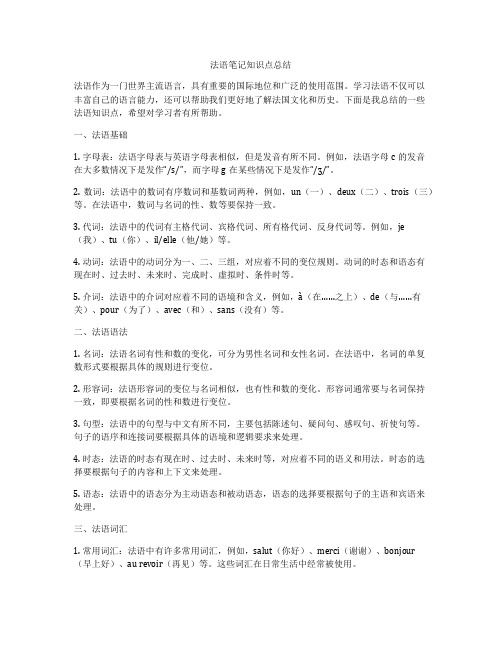
法语笔记知识点总结法语作为一门世界主流语言,具有重要的国际地位和广泛的使用范围。
学习法语不仅可以丰富自己的语言能力,还可以帮助我们更好地了解法国文化和历史。
下面是我总结的一些法语知识点,希望对学习者有所帮助。
一、法语基础1. 字母表:法语字母表与英语字母表相似,但是发音有所不同。
例如,法语字母c的发音在大多数情况下是发作“/s/”,而字母g在某些情况下是发作“/ʒ/”。
2. 数词:法语中的数词有序数词和基数词两种,例如,un(一)、deux(二)、trois(三)等。
在法语中,数词与名词的性、数等要保持一致。
3. 代词:法语中的代词有主格代词、宾格代词、所有格代词、反身代词等。
例如,je (我)、tu(你)、il/elle(他/她)等。
4. 动词:法语中的动词分为一、二、三组,对应着不同的变位规则。
动词的时态和语态有现在时、过去时、未来时、完成时、虚拟时、条件时等。
5. 介词:法语中的介词对应着不同的语境和含义,例如,à(在……之上)、de(与……有关)、pour(为了)、avec(和)、sans(没有)等。
二、法语语法1. 名词:法语名词有性和数的变化,可分为男性名词和女性名词。
在法语中,名词的单复数形式要根据具体的规则进行变位。
2. 形容词:法语形容词的变位与名词相似,也有性和数的变化。
形容词通常要与名词保持一致,即要根据名词的性和数进行变位。
3. 句型:法语中的句型与中文有所不同,主要包括陈述句、疑问句、感叹句、祈使句等。
句子的语序和连接词要根据具体的语境和逻辑要求来处理。
4. 时态:法语的时态有现在时、过去时、未来时等,对应着不同的语义和用法。
时态的选择要根据句子的内容和上下文来处理。
5. 语态:法语中的语态分为主动语态和被动语态,语态的选择要根据句子的主语和宾语来处理。
三、法语词汇1. 常用词汇:法语中有许多常用词汇,例如,salut(你好)、merci(谢谢)、bonjour(早上好)、au revoir(再见)等。
法语的历史变迁与法国语言政策

法语在法国国内的应 用
法语在法国国内的应用范围和特点
官方语言:法语是法国的 官方语言,用于政府、教
育、媒体等各个领域。
地域差异:法国各地区的 法语存在一定的地域差异, 如口音、词汇和语法等方
面。
语言政策:法国政府对法 语的使用有严格的规定, 如公共场合必须使用法语, 学校教育必须使用法语等。
法语在教育、科研、商务等领域也有着广泛的应用,为各国之间的交流和合 作提供了便利。
法语在教育领域的应用
法语在教育领域的应用包括: 法语教学、法语考试、法语 教材等
法语在教育领域的应用有助 于提高学生的语言能力和国
际视野
法语作为世界第二大语言, 在全球范围内广泛使用
法语在教育领域的应用还可 以促进不同文化之间的交流
文化的影响
法国语言政策对法语的影响
法国政府对法语的保护和推广
法语在教育、媒体、文化等领 域的应用和地位
法语与其他语言的融合和影响
法国语言政策对法语发展的影 响和挑战
法国语言政策的演变
01
中世纪时期:法语成为法国的官方 语言
03
17世纪:法国科学院成立,规范法 语语法和词汇
05
19世纪:法国政府推行法语教学, 推广普及法语
世界贸易组织:法语是该组织的工 作语言之一
04
05
国际红十字会:法语是该组织的工 作语言之一
国际法庭:法语是该法庭的官方语 言之一
06
法语在文化交流中的应用
法语是联合国六大工作语言之一,广泛应用于国际会议、文件和交流中。
法语是欧洲第二大语言,仅次于英语,广泛应用于欧洲各国之间的交流和合 作中。
法语在文学、艺术、哲学等领域有着丰富的文化遗产和影响力,对世界文化 产生了深远的影响。
初中法国语言文化知识点总结

初中法国语言文化知识点总结法国是一个历史悠久、文化繁荣的国家,拥有丰富的语言和文化背景。
法国语言文化知识点总结如下:1. 法语:法语是法国的官方语言,也是法兰西语言族的一种。
它在世界范围内被广泛使用,是联合国和国际奥委会的官方工作语言之一。
法语有丰富的词汇和复杂的语法结构,学习者需要掌握基本的单词、句型和发音规则。
2. 文学:法国是文学的重要发源地之一。
许多世界著名的作家和文学流派都起源于法国,如大仲马的《基督山伯爵》和《悲惨世界》,埃克多·罗曼的《傲慢与偏见》,维克多·雨果的《巴黎圣母院》等。
法国文学注重表现内心世界和人性的探索,给读者带来了深刻的思考和艺术享受。
3. 艺术:法国是世界艺术的重要中心之一。
卢浮宫是全球最著名的艺术博物馆之一,收藏了大量的古代艺术品和现代绘画作品。
卢浮宫的代表性作品包括达·芬奇的《蒙娜丽莎》,毕加索的《争斗牛》和梵高的《星夜》等。
此外,巴黎的蓬皮杜艺术中心是当代艺术的重要展示场所。
4. 音乐:法国音乐历史悠久,以巴黎为中心成为欧洲音乐之都。
法国著名的古典音乐家包括德彪西、拉威尔和德利布。
同时,法国也是爵士、流行和摇滚音乐的重要发展地,法国乐队酷玩乐队和达摩克利斯乐队等在国际上享有盛誉。
5. 食物:法国是世界著名的美食之国。
法国菜以其精致的烹饪技巧和复杂的味道而闻名,其中包括鹅肝、培根、奶酪和红酒等。
法国餐桌礼仪也十分重要,法国人通常会慢慢享用食物,尊重用餐的过程。
6. 建筑:法国拥有世界上许多著名的建筑物,如埃菲尔铁塔、巴黎圣母院和凡尔赛宫等。
这些建筑充满着历史和艺术的魅力,吸引着来自世界各地的游客。
7. 时尚:法国被认为是时尚的中心之一。
巴黎是全球时装界的重要中心,每年都有世界知名的时装周在巴黎举行。
法国设计师如高尔蒂埃、香奈儿和迪奥等在时尚界有着重要的地位。
总结起来,法国拥有丰富多样的语言和文化,无论是法语、文学、艺术、音乐、食物、建筑还是时尚,都展现了法国人民的创造力和独特的审美观。
《中法语言政策研究(第三辑)》读书笔记模板

保护多种语言活力,服务国家发展所需
一、两大基本理念 二、语言生态现状 三、语保工作评估 四、服务终极目标 五、结语
水书古籍文献中的语言资源及利用研究
一、水书文献的语言特征 二、水书文献中的语言资源 三、水书文献中语言资源的利用及传承
跨越鸿沟,寻找最有效的方式
一尴尬的语保 二、大卫·克里斯特尔的观点 三、寻找最有效的方式 四、结语
目录分析
多元文化与多语主义
加强语言政策交流合 作,推进中法人文交
流全面深入发展
地方语言的推广和保 护
见证历史传承文明, 搭建中外文化交流桥 梁
1
中法教育合作
中法语言合作, 2
两国的工作重 点
3 语言政策交流
合作,促进中 法文明互鉴
4 中国语言的法
律及其政策的 价值
5 中法携手培养
语言文化交流 人才
外语教育中目标语文化与本土文化的关系
一、评析语言与文化的传统观念 二、重释语言与文化的关系 三、对处理目标语文化和本土文化关系的建议
中国的翻译教育:挑战与未来
一、翻译专业教育及翻译研究概况 二、社会对翻译人才的需求 三、迎接挑战,寻找解决方案 四、结论
法国在华企业的语言使用现状
一、引言 二、中法语言政策有关企业语言的规定 三、中法语言使用报告中的调查事实 四、法国在华企业语言使用情况 五、形成原因和结论
4 水书古籍文献
中的语言资源 及利用研究
5 跨越鸿沟,寻
找最有效的方 式
语言传播成功的标识 与条件
论17—18世纪来华 传教士对汉语传播的
推动作用
多语言服务与人文交 流
外语教育中目标语文 化与本土文化的关系
法国在华企业的语 言使用现状
英法日常文

英法日常文摘要:1.英法两国的语言和文化背景2.英法日常文的特点和用途3.英法日常文的发展历程4.英法日常文的影响和未来展望正文:英法日常文,是指在英国和法国日常生活中使用的文字,这两种文字在语言和文化背景上有很大的差异,各有其独特的特点和用途。
首先,英法两国的语言和文化背景各有不同。
英国的语言主要是英语,而法国的语言主要是法语。
英语属于日耳曼语系,法语则属于罗曼语系。
在文化方面,英国文化深受盎格鲁- 撒克逊人的影响,强调个人主义和实用主义;法国文化则深受拉丁文化的影响,强调理性和人文主义。
这些差异使得英法两国的日常文在表达方式和语言风格上有很大的不同。
英法日常文的特点和用途也非常明显。
英国的日常文通常比较简洁明了,注重逻辑性和条理性,常用于书写信件、报告和论文等;而法国的日常文则较为华丽,注重修辞和情感表达,常用于书写诗歌、小说和散文等。
此外,英法日常文在拼写、语法和词汇等方面也有很大的不同,需要学习者特别注意。
英法日常文的发展历程也非常有趣。
在历史上,英国和法国都曾经是罗马帝国的一部分,两国的语言都受到拉丁语的影响。
然而,随着历史的发展,英法两国的语言逐渐分化,形成了各自独特的语言和文字系统。
在现代,英法日常文已经成为世界范围内广泛使用的文字之一,对全球文化交流和经济发展产生了深远的影响。
英法日常文对世界文化的影响是不容忽视的。
随着英法两国在政治、经济和文化等领域的影响力不断扩大,英法日常文也成为了国际交流的主要语言。
许多国家和地区都将英法日常文作为外语进行学习和使用,英法日常文的影响力和地位不断提高。
对于英法日常文的未来展望,我们可以看到,随着全球化的不断深入,英法日常文的使用范围将会进一步扩大。
同时,随着科技的发展,英法日常文的表达方式和传播渠道也将发生新的变化。
英国语言政策

留学培训服务
(一)各大学陆续成立了语言培训中心,为外国学生提供短期的 (从数周至2、3个学期)的集中英语训练或分散的课余英语补习。 培训中心规模不一,大都附属于语言学系,又具有相对独立性。
培训中心的教学通常包括三方面:
(1)提高学生一般英语水平
(2)教授专门用途英语及学术用途英语
(3)培训英语教师,通常是非英语国家派出的教师经一年以下的 培训取得文凭。
✓ 1967年“英语应用语言学学会”成立,成为“英语教师的教师”的专业组织。 ✓ 1967年“国际英语外语教师协会”成立,致力于对外英语教学,通过建立国际
性的专业社区,将世界各地的对外英语教师联系在一起,支持其对外英语 教学工作。
英国的所有院校均制定有明文章程,并接受“高等教育拨款委员会 “(HEFCE)和”高等教育质量委员会“(HEQC)这两家全国性机构的监督。 1997年为保证英国院校提供更高质量的教学服务,上述两家机构合并 成“英国高等教育质量保证署。 在专业性的对外教师培训学校监督方面,英国文化委员会和英国英语 协会是两大主要机构。两者共同负责英国国内的英语语言学校和机构 的认证工作。
对外英语教学师资培养
英国国内培养海外英语语言教师的语言学校主要开设有两类课程: (1)“英语作为外语”硕士学位课程,培养目标紧扣未来的实际教学,不侧 重应用语言学理论的教学,强调教学法的教学。 (2)“应用语言学”硕士学位课程,学生多为有一定教学经验的英语教师, 年龄偏大。较为注重应用语言学理论和语言学分支学科的教学。难度要 大一些,但学术含量更高。
4.4 紧跟技术变革不断调整语言推广方式
随着计算机和网络技术的迅猛发展,在1996年,英国文化委员会便 正式开通官方网站宣传英国文学艺术方面的灿烂文明和英语教学的 成绩
法语口译课堂笔记分享
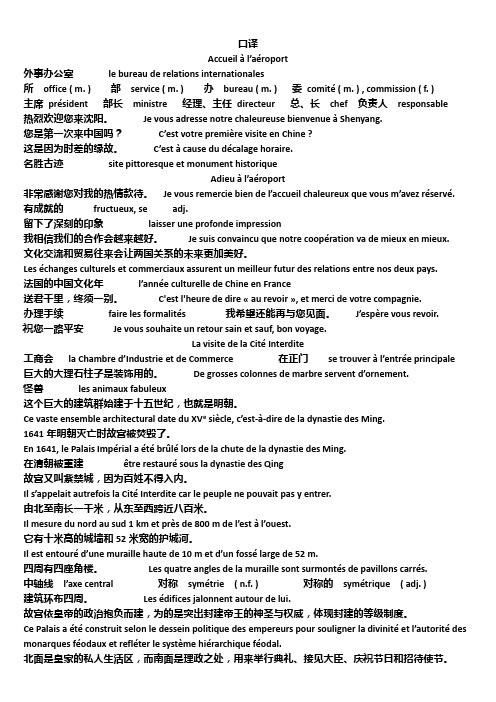
口译Accueil à l’aéroport外事办公室le bureau de relations internationales所office ( m. ) 部service ( m. ) 办bureau ( m. ) 委comité ( m. ) , commission ( f. )主席président 部长ministre 经理、主任directeur 总、长chef 负责人responsable热烈欢迎您来沈阳。
Je vous adresse notre chaleureuse bienvenue à Shenyang.您是第一次来中国吗?C’est votre première visite en Chine ?这是因为时差的缘故。
C’est à cause du décalage horaire.名胜古迹site pittoresque et monument historiqueAdieu à l’aéroport非常感谢您对我的热情款待。
Je vous remercie bien de l’accueil chaleureux que vous m’avez réservé.有成就的fructueux, se adj.留下了深刻的印象laisser une profonde impression我相信我们的合作会越来越好。
Je suis convaincu que notre coopération va de mieux en mieux.文化交流和贸易往来会让两国关系的未来更加美好。
Les échanges culturels et commerciaux assurent un meilleur futur des relations entre nos deux pays.法国的中国文化年l’année culturelle de Chine en France送君千里,终须一别。
双语国家的语言状况及其政策提纲

浅谈双语国家的语言状况及其政策内容摘要:关键词:比利时王国1.比利时王国的官方语言:荷兰语(佛拉芒语57.89%)和法语(瓦隆语32.72%),此外还包括非官方语言德语(低地德语0.68%)和其它语言2.比利时王国的社会背景以及语言状况:⏹比利时位于欧洲西部,东部,东南部。
西部和南部与法国交界,北部与荷兰接壤,东部和东南部与德国和卢森堡相邻。
国土面积3.05万平方公里。
⏹据1993年的数据显示全国总人口1010.3万人。
比利时拥有诸多民族,以佛拉芒人和瓦隆人为主体,还包括不到1%的德意志人。
⏹佛拉芒语也就是所谓的荷兰语,但是因为在不同的政治体系中,所以名称也不一样,后规范为荷兰语。
⏹佛拉芒语是印欧语系日耳曼语族西支⏹15世纪末比利时荷兰卢森堡和法兰西北部统称为尼德兰,再西班牙的统治之下。
之后荷兰成为了欧洲最先强大民族,留下了书面语,⏹但是尼德兰南部地区的人们仍然在西班牙的统治之下,后发展为佛拉芒人,随着独立,经济,文化和宗教的不断发展,最终成为了两种不同的人,即佛拉芒人和荷兰人,但是两种语言很是相近,随着频繁的交往,两种语言的差别就被无限的缩小了。
⏹瓦隆语属于印欧语系罗曼语族,是一种法国北部的方言。
主要分布在比利时南部和首都布鲁塞尔。
⏹德语属于印欧语系日耳曼语族。
比利时的德语属于低地德语。
⏹语区的划分:主要分为南部和北部两大语区,大致上,北部为荷兰语,南部为法语,除了两大语区,还可分为四块,既加上首都布鲁塞尔荷兰语与法语的双语区,以及很小部分德意志人所说的德语区。
⏹官方语言使用情况:比利时的官方语言是法语和荷兰语,通用于议会,行政,司法等公共领域和地方政府的各个部门。
国家公务员处长及处长以上的官员,大臣,首相等等,都来自这两大语言集团。
并且要求其比例要均衡。
并且在教育方面,佛拉芒地区教学母语为荷兰语,但第二语言必须是法语。
瓦隆地区教学母语为法语,第二语言必须为荷兰语。
德语地区使用的德语,第二语言为法语。
语言与国家笔记
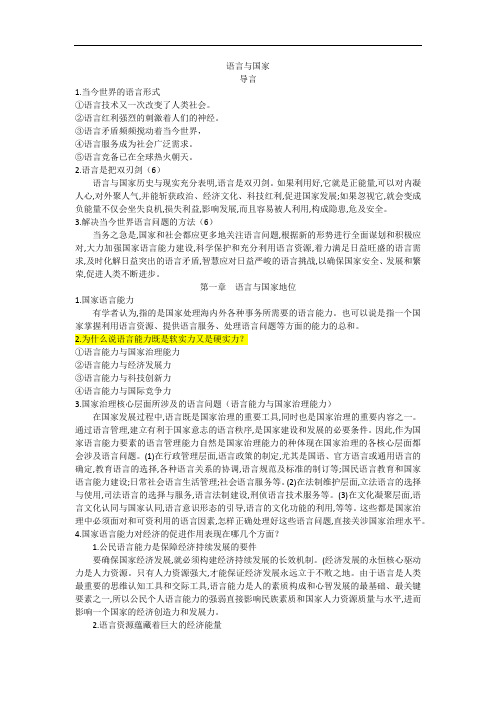
语言与国家导言1.当今世界的语言形式①语言技术又一次改变了人类社会。
②语言红利强烈的刺激着人们的神经。
③语言矛盾频频搅动着当今世界,④语言服务成为社会广泛需求。
⑤语言竞备已在全球热火朝天。
2.语言是把双刃剑(6)语言与国家历史与现实充分表明,语言是双刃剑。
如果利用好,它就是正能量,可以对内凝人心,对外聚人气,并能斩获政治、经济文化、科技红利,促进国家发展;如果忽视它,就会变成负能量不仅会坐失良机,损失利益,影响发展,而且容易被人利用,构成隐患,危及安全。
3.解决当今世界语言问题的方法(6)当务之急是,国家和社会都应更多地关注语言问题,根据新的形势进行全面谋划和积极应对,大力加强国家语言能力建设,科学保护和充分利用语言资源,着力满足日益旺盛的语言需求,及时化解日益突出的语言矛盾,智慧应对日益严峻的语言挑战,以确保国家安全、发展和繁荣,促进人类不断进步。
第一章语言与国家地位1.国家语言能力有学者认为,指的是国家处理海内外各种事务所需要的语言能力。
也可以说是指一个国家掌握利用语言资源、提供语言服务、处理语言问题等方面的能力的总和。
2.为什么说语言能力既是软实力又是硬实力?①语言能力与国家治理能力②语言能力与经济发展力③语言能力与科技创新力④语言能力与国际竞争力3.国家治理核心层面所涉及的语言问题(语言能力与国家治理能力)在国家发展过程中,语言既是国家治理的重要工具,同时也是国家治理的重要内容之一。
通过语言管理,建立有利于国家意志的语言秩序,是国家建设和发展的必要条件。
因此,作为国家语言能力要素的语言管理能力自然是国家治理能力的种体现在国家治理的各核心层面都会涉及语言问题。
(1)在行政管理层面,语言政策的制定,尤其是国语、官方语言或通用语言的确定,教育语言的选择,各种语言关系的协调,语言规范及标准的制订等;国民语言教育和国家语言能力建设;日常社会语言生活管理;社会语言服务等。
(2)在法制维护层面,立法语言的选择与使用,司法语言的选择与服务,语言法制建设,刑侦语言技术服务等。
欧洲的两种政治语言:英格兰和法国革命

欧洲的两种政治语言:英格兰和法国革命编者按:其实本来是打算单独发一篇埃德蒙·伯克的,只能后续再发了。
确实是写得长。
我要考虑篇幅的问题。
关于法国大革命的论战,埃德蒙·伯克一如既往地冷静、欠缺激情,如同《大陆法系》里所写:可憎的过去被描绘得过于可怕……伯克没有人类冲昏头脑式的理性狂热,他批评法国大革命,批评理性。
会努力找时间写下伯克的《关于崇高与美丽的概念的哲学探究》,你会发现,伯克认为“凡是让人们觉得恐怖的,他们都会误以为是高尚。
”我大声宣告我的原则,因为我如此确定如果人类可以坦荡公正地行为,宣誓他们内心真正的感受,那么这统治欧洲多年的恐怖和暴政体制将会被一扫而空,且不会有一个牺牲者。
法国大革命的原则让我荣耀!我沉浸在理性的胜利里!我是人类权利的拥护者!--- 约翰·塞瓦尔(John Thelwall )(1795)1789年是关键性的一年——它是一个分水岭。
就在这一年,旧制度被摧毁,理性和正义取代了它。
法国大革命开启了现代社会。
令人印象深刻!同样,这也是革命者自己所看到的。
这就是威廉·华兹华斯(1770-1850)所经历的。
O pleasant exercise of hope and joy!For mighty were the auxiliars which then stoodUpon our side, we who were strong in love;Bliss was it that dawn to be alive,But to be young was very Heaven:O times,In which the meagre, stale, forbidding waysOf custom, law, and statute took at onceThe attraction of a Country in Romance;When Reason seem'd the most to assert her rightsWhen most intent on making of herselfA prime enchantress -- to assist the work,Which then was going forward in her name.Not favor'd spots alone, but the whole Earth!(理查德·费雪)在1789年11月4日,不满的牧师理查德·费雪(Richard Price)(1723-1791)在伦敦律师学院旁的会议楼做旧约的布道。
LE FRANCAIS I 笔记

发音一、读音规则1、除r,c,f,l,q,ct外,其它辅音字母在词末一般不发音。
2、[K],[p],[t]音在词末要送气。
3、两个元音这间的单辅音属于下一个音节,相连的两个辅音必须分开,如有三个辅音相连,前两个辅音属于上一音节,后一个辅音属于下一音节。
4、gu在e,I,y前也读[g]音。
5、X一般读[ks],在词末则读[s],或不发音。
但在联诵中读[z]。
6、字母h都不发音,但有两种情况,哑音h,前面的词和它之间可以有联诵或省音,嘘音h则不可。
7、分音符“..”加在元音字母之上,表示该元音字母应与前面的元音字母分开读音。
8、当ti后面是元音字母,而t前又没有[s]音时,ti读[si]或[sj],如démocratie,partiel;如果有[s]音,发音就要变。
9、动词变位中,第三人称复数词尾的ent本身不发音。
10、鼻化元音后如果有元音字母或m,n,就不能发鼻化元音。
11、i在辅音群与元音之间时读[ij],如:ouvrier [uvrije]12、词首eff-,ess-读[e],如effet,essai13、字母ou在半元音[j]前仍然读[u]的音。
14、ail,aille读[a:j];eil,eille读[8:j]15、字母s在两个元间之间读[z]音。
二、省音少数以元音字母结尾的单音节词,常和下一词的词首元音合读成一个音节,而省去词末的元音字母。
Ce,se,que,je,te,me,le,ne,,la,de,,,,,,三、连音、联诵1、连音代词主语后面的动词如果是以元音或哑间“h”开始,那么它们必须连音。
如果主语不是代词,则不能连音。
2、联诵在同一节奏组中,前一词词末如果是原来不发音的辅音字母,而后一词以元音开始,则前一辅音字母应当发音,并与后面的词首元音合成一个音节,这种现象叫联诵。
不能联诵的情况:主语是代词的主谓倒装的疑问句中,倒装之后的主语人称代词和其后的成分不能联诵,如:etes-vous etudiant?连词et不能和后面的词联诵。
- 1、下载文档前请自行甄别文档内容的完整性,平台不提供额外的编辑、内容补充、找答案等附加服务。
- 2、"仅部分预览"的文档,不可在线预览部分如存在完整性等问题,可反馈申请退款(可完整预览的文档不适用该条件!)。
- 3、如文档侵犯您的权益,请联系客服反馈,我们会尽快为您处理(人工客服工作时间:9:00-18:30)。
Language Policy in Britain and FranceChapter 1Theoretical considerations: sociolinguistics, policy studies and language planning 1.Cooper (1989, 31,183), defining language planning as 'deliberate efforts to influence the behaviour of others with respect to the acquisition, structure, or functional allocation of their language codes' rejected definitions of language planning which: restrict language planning to activities undertaken by governments, government-authorised agencies, or other authoritative bodies, i.e. organisations witha public mandate for language regulation.2. Fasold (1984, 250) agreed that language planning is an 'explicit choice between alternatives', he suggested that there are two ways this can be done: the instrumental - planners choose a language or improve one, since 'language is a tool' to greater efficiency; or the sociolinguistic - planners try to solve a social problem, taking into account the symbolic value of languages and weighing the social consequences of their choice.3.Chaudenson and Robillard, 1989, 24) noted that 'language planning' as a field of study originated among English-speaking specialists involved with the social and economic problems of newly independent States, mainly after the Second World War.4.('policy') as all national choices concerning language and culture, specifying general long-term objectives (educational levels, training, employment, function and status of languages, etc.) and founded on an analysis of the starting position.('planning') would apply to any long-, short- or medium-term operation aimed at putting the objectives defined by policy into operation, taking into account the means provided and the procedures envisaged.(language management and control) very diverse actions leading to the concrete realisation of operations defined in the preceding two categories, and made it clear that for him amenagement linguistique was not to be confused with corpus planning.5.The types of language behaviour such actors have tried to influence have been acquisition planning (teaching and learning), corpus planning (the structure of language) and status planning (the functional allocation of languages or language varieties). Language planning activities can usually be classified and distinguished from each other under these headings, and useful distinctions in terminology have followed from clarification of the activities.6.Acquisition planning can apply to the teaching and learning of first languages (LI), sometimes referred to as native languages, mother tongues or maternal languages, or as vernacular languages; to second languages (SL or L2), which are those used as vehicular languages to enable the learner to participate in his or her society; and foreign languages (FL), those learnt later for a variety of reasons involving communication with other societies, but which are not in normal everyday use within the learner's society.7.Acquisition planning generally has had clear social purposes in influencing the behaviour of those who will be society's future members. Thus the adoption of a new foreign language in the schools responds to the new political commitments - Swedishand Finnish start to be taught throughout Europe as Sweden and Finland become members of the European Union; Armenian is accepted at baccalaureat level because Armenian is the language of a large immigrant group in France which society should recognise; French must be the language of education in all French schools because it is the language of the State, and only through knowledge of French can social integration be assured.8.Corpus planning is normally understood as action to improve the ability of a language to respond to change; it is often, though not always, concerned with modernising the word stock of the language. George Thomas (1991, 76-81) discussed corpus planning as social behaviour, examining the attitudes different types of purism revealed. Archaising purism thus demonstrates reverence for the past; ethnographic purism, seeking purer language in folk dialects and in popular and rural forms is one manifestation of the rejection of 'advanced' urban society; elitist purism 'embodies a negative, proscriptive attitude to substandard and regional usage', aiming at promoting the language, values and social ideology of the elite. Reformist purism may involve the repudiation of a foreign model, or of a language associated with former political domination, and requires the planner to modernise, to 'reform, regenerate, renew or resuscitate a language' in order to support a new sense of social belonging. Xenophobic purism derives from a rejection of foreigners or foreign customs. All these motivations, except possibly the xenophobic, 'are intended to have some improvement of the language as an end result', although 'anti-purism' tries to correct the effects particularly of xenophobic purism. Finally Thomas, perhaps at a loss to explain some types of purist action in terms of their effect on social behaviour, also felt that some apparently non-rational actions originated in pure play: 'there are instances where purism is an end in itself, little more than a literary or aesthetic game'.9.Status planning involves attempts to change the relative prestige in which a particular political or ethnic community holds a language or language variety. It is usually carried out to raise prestige, through ensuring that the language is used in some prestigious domains such as those of public life, rather than in non-prestigious ones like the home or the local cafe. Generally speaking, the greater the number of domains of use, and the more significant they are to the public and official life of the community, the higher the status; the higher the status, the greater the prestige that will then be accorded to the language (Mekacha, 1994).The significance of language use depends on the functions to which it, or a variety or code of language, is assigned within such domains. Status planning hence aims at influencing society's functional allocation of language codes. Stewart (1968, quoted in Cooper, 1989, 99-119), listed such allocations as:o: official (politically or culturally representative purposes);p: provincial (provincial or regional official language);w: wider communication (across language boundaries within the nation);i: international (e.g. diplomatic relations, trade, tourism);c: capital city;g: group (i.e. tribe, settled group of immigrants); e: educational; s: school subject;1: literary; r: religious.Cooper adds two more: mass media and work, and we shall return to the question of domains and functions when considering the contribution of sociolinguistics to identifying types of community as targets of language policy.10.It is useful to keep clear the distinctions between status, corpus and acquisition policy in order to clarify the types of behaviour it is intended should be influenced, although much language policy is not in practice restricted to one or other of these main types: choosing one language rather than another to be learnt in the foreign language classroom often affects its relative status within society at large, and writing a new dictionary -standardising the language as an act of corpus policy - makes acquiring the language easier, or in some cases possible. Indeed, language policy -particularly where matters of status are concerned - may often really be a cover for some other type of policy altogether, while social policy - on education, social benefits or voting rights, for example - may well have linguistic consequences. Chapter 2The development of the standard language1.SelectionIn England, the dialect which had probably gained ascendancy after the arrival of the Angles, the Saxons and the Jutes from 449 until just before the Norman Conquest was West Saxon, which had achieved the status of a national preferred literary form and, as the language of Alfred the Great, was politically important if not pre-eminent. The Norman Conquest of 1066 however - the 'most significant historical event' in the history of the language (Finegan, 1987) - prevented the selection of a pre-existing dialect of English as the standard, and might well have imposed Norman French as both standard and official language on the conquered populations. Indeed, Norman French was the official language for at least a century and a half after 1066, a period during which diglossia characterised the country and individual bilingualism is not thought to have been very widespread.The turn of the linguistic tide is usually dated as 1204, when King John lost Normandy and he and successive kings were forced to concentrate on their possessions in Britain. After this time, and particularly after the Black Death of 1348, English became more widespread and gained prestige. Following the Statute of Pleading of 1362, which required English rather than French or Latin to be used in the law courts, 'English again became the language of England and of her literature' (Finegan, 1987, 84). By 1362 'English', heavily affected by the impact of the French and then the Anglo-Norman dialect of the conquerors, was in fact already the spoken language of the courts, although Latin was retained as the language of written record. But which dialect form of this new 'English' would be selected? Throughout the period 1400-1600 the five regional dialects (Southern, South-Eastern, West and East Midlands, and Northern) all continued to be used, with 'important Middle English texts in every one' (Price, 1984, 175). By about 1470, however, most writing seemed to reflect East Midlands usage. The process of dialect selection in England was probably based on bureaucratic practice (the language of the king's clerks) in addition to literature (Chaucer), education and learning (Oxford and Cambridge), political power (the London Court) and the prestige of the written form (after Caxton's invention of the printing press in 1476), so the selection was as much social as political, and certainly not so 'military' as that of France (cf. Grillo, 1989, 155-62, who characterises the influences as 'Chaucer, Chancery and Caxton').There was, of course, no question of selecting any of the regional languages, even in Wales, Scotland or Ireland. The aim of converting Catholics to Protestantism was one of the main motivating factors for the spread of English into these countries, although it was by no means the only one. The education of the masses, for example, was thought to be hindered by their use of indigenous languages, so even as late as the 1847 'Blue Books' (reports of the Commissioners on the state of education inWales), officials could cheerfully state that 'the Welsh language is a vast drawback to Wales, and a manifold barrier to the moral progress and commercial prosperity of the people' (quoted in Grillo, 1989, 87). Religion and education were, however, inextricably linked: if for some, progress could only come through the use of the standard language, for others, using the standard language meant rejecting their identity. Throughout Britain churches and groups such as the Society for the Propagation of Christian Knowledge, the Irish 'Hedge Schools', and the Edinburgh Gaelic School Society, made the Bible and other texts available in the local language, and taught in Welsh or (Irish and Scottish) Gaelic, keeping the indigenous languages alive, in some cases even against the law (teachers of Irish were proscribed in Ireland until 1792).The Education Acts of 1870 and 1872 ensured more direct state, rather than religious, involvement with education, although the system was locally managed and controlled. Neither Act made provision for teaching in languages other than English, although local codes of practice made provision in Welsh, Scottish and Irish Gaelic possible in the elementary and later in the intermediate schools.2.Codification, the rejection of dialect and specialist terms and the reduction of the language to an efficient, usable instrument, was carried out by many different hands, although the most visible forms were those affecting literary and courtly language. The codification of English took place also from about the sixteenth century, through the publication of dictionaries and grammars, many of them intended to teach the language to rural squires or to the 'Welsh gentry' after the 1536 Act of Union between England and Wales. Written standard English was codified through the sixteenth and seventeenth centuries, although Jonathan Swift's 'Proposal for Correcting, Improving and Ascertaining the English Tongue' appeared in 1712, the grammar of Bishop Lowth in 1762, and Samuel Johnson's dictionary did not appear until 1755. Throughout this codification process three influences were again paramount: the king's English, in the form of the administrative and legal language; literary English, in the form of the language accepted as that used by great literature -and used for printing and publishing; and 'Oxford English', or the English of education and the Church - its main provider. At no point in this process was the State openly involved.Codification also affected the spoken form of the standard language. 'Received pronunciation' was codified through the influence of education, particularly that of the nineteenth-century public schools, followed from the early twentieth century by cinema, radio and television ('BBC English'). Nonetheless it is estimated that only 3-5 per cent of the population of Britain speak received pronunciation today (Trudgill and Hannah, 1982), and hence this particular form of the spoken language is 'accepted' by society only in the sense that it is widely understood.Codification of English has produced at least two standard languages - the British and the North American, although the differences between the two are matters of pronunciation and the lexicon, rather than affecting anything more seriously structural. Any work by an academy to codify either of the two standards 'has been consistently rebuffed, and any suggestion of an international academy would almost certainly be met with international ridicule' (Finegan, 1987, 101), so the two codified norms have separate existence, with separate authorities being consulted - Webster's Dictionary (first edition 1828) for America and the Oxford English Dictionary (first instalment of the first edition 1884) for the British.2.SelectionIn England, the dialect which had probably gained ascendancy after the arrival of the Angles, the Saxons and the Jutes from 449 until just before the Norman Conquest was West Saxon, which had achieved the status of a national preferred literary form and, as the language of Alfred the Great, was politically important if not pre-eminent. The Norman Conquest of 1066 however - the 'most significant historical event' in the history of the language (Finegan, 1987) - prevented the selection of a pre-existing dialect of English as the standard, and might well have imposed Norman French as both standard and official language on the conquered populations. Indeed, Norman French was the official language for at least a century and a half after 1066, a period during which diglossia characterised the country and individual bilingualism is not thought to have been very widespread.The turn of the linguistic tide is usually dated as 1204, when King John lost Normandy and he and successive kings were forced to concentrate on their possessions in Britain. After this time, and particularly after the Black Death of 1348, English became more widespread and gained prestige. Following the Statute of Pleading of 1362, which required English rather than French or Latin to be used in the law courts, 'English again became the language of England and of her literature' (Finegan, 1987, 84). By 1362 'English', heavily affected by the impact of the French and then the Anglo-Norman dialect of the conquerors, was in fact already the spoken language of the courts, although Latin was retained as the language of written record. But which dialect form of this new 'English' would be selected? Throughout the period 1400-1600 the five regional dialects (Southern, South-Eastern, West and East Midlands, and Northern) all continued to be used, with 'important Middle English texts in every one' (Price, 1984, 175). By about 1470, however, most writing seemed to reflect East Midlands usage. The process of dialect selection in England was probably based on bureaucratic practice (the language of the king's clerks) in addition to literature (Chaucer), education and learning (Oxford and Cambridge), political power (the London Court) and the prestige of the written form (after Caxton's invention of the printing press in 1476), so the selection was as much social as political, and certainly not so 'military' as that of France (cf. Grillo, 1989, 155-62, who characterises the influences as 'Chaucer, Chancery and Caxton').There was, of course, no question of selecting any of the regional languages, even in Wales, Scotland or Ireland. The aim of converting Catholics to Protestantism was one of the main motivating factors for the spread of English into these countries, although it was by no means the only one. The education of the masses, for example, was thought to be hindered by their use of indigenous languages, so even as late as the 1847 'Blue Books' (reports of the Commissioners on the state of education in Wales), officials could cheerfully state that 'the Welsh language is a vast drawback to Wales, and a manifold barrier to the moral progress and commercial prosperity of the people' (quoted in Grillo, 1989, 87). Religion and education were, however, inextricably linked: if for some, progress could only come through the use of the standard language, for others, using the standard language meant rejecting their identity. Throughout Britain churches and groups such as the Society for the Propagation of Christian Knowledge, the Irish 'Hedge Schools', and the Edinburgh Gaelic School Society, made the Bible and other texts available in the local language, and taught in Welsh or (Irish and Scottish) Gaelic, keeping the indigenous languages alive, in some cases even against the law (teachers of Irish were proscribed in Ireland until 1792).The Education Acts of 1870 and 1872 ensured more direct state, rather than religious, involvement with education, although the system was locally managed and controlled. Neither Act made provision for teaching in languages other than English, although local codes of practice made provision in Welsh, Scottish and Irish Gaelic possible in the elementary and later in the intermediate schools.3.ElaborationIn English, 'generally speaking, the sixteenth and seventeenth centuries are the centuries of vocabulary expansion in response to the need for functional elaboration of the developing standard - in science, philosophy and literature' (Milroy, J., 1984, 13). Like French, English borrowed extensively - from French in particular, from which language it took not merely vocabulary items but also a range of derivational systems of prefixes and suffixes. In science and technology, English borrowed, and still does, extensively from Latin and Greek, although 'mastery of the Latinate vocabulary of English is difficult and requires the support of a strong educational system' (Milroy, J., 1984, 28).4.AcceptanceThe acceptance of standard language throughout the British speech community is by no means general, and much of the debate over questions of identity, of the teaching of the standard language in a national curriculum, over 'sloppiness' in language use, and over the assimilation of immigrant communities through language is related to intra-language variation and to social dialects. Gillian Shephard, Secretary of State for Education, put the case for accepting standard English as an entitlement for all citizens succinctly at the Conservative Party Conference in October 1994, and indeed repeated the message at the 1995 conference:For too long we have been too slack in our treatment of English. And we haveimpoverished our children in the process. That is why the National Curriculum . . . puts the emphasis firmly on standard English. Children must be able to master these essential tools if they are to express themselves clearly and make their way successfully in the world.The opposite point of view was expressed by Alan Howarth in an article in the Guardian (15 October 1994). A former Conservative Minister of Education, he noted that 'the prosperous are nervous about the poor' and described the concern with standard English as 'cultural authoritarianism', based on potentially 'ugly and dangerous values': 'Presumably if the underclass and immigrants won't understand about subordinate clauses and the subjunctive mood, they are beyond the pale.' His distaste for some of these feelings may have contributed to his departure from the party in October 1995.Chapter 4Constituent, corpus and acquisition policiesACQUISITION POLICIESThe teaching of English in BritainIt is in this area that recent British governments have been most active in recent years, slowly developing a national policy for English whose aims and purposes are mixed: to improve the learning and teaching of the language but also to ensure that a certain type of English - and the associated cultural 'baggage' - is transmitted through the schools.The Bullock Report of 1975 had advocated an awareness of and sympathy for the 'linguistic and cultural diversity' of children, meaning by this 'the language and culture of the home', which 'no child should be expected' to 'cast off as he crosses the school threshold and the curriculum should reflect those aspects of his life'. This attitude of respect for social as well as cultural diversity, elevating working-class culture to the level of that of the elite, had changed somewhat in the Swann Report of 1985, which saw standard English as having a major role in unifying the country. The process continued in the Kingman Report of 1988, which outlined four reasons for supporting the teaching of standard English (defined as an 'overarching' variety) to all pupils: it contains the best of the national heritage, it is the language all Britons have in common, it is the only variety not associated with territory, and it is that best suited for the transmission of culture, for literature and for literacy.1988The 1988 Education Reform Act required the Secretary of State to make orders specifying the content of the National Curriculum, in English as in other subjects. Just prior to the passage of this Act, the Kingman Report had given some idea of the direction the debate would take and of the way in which policy towards the teaching of English would reflect the concerns of national identity and 'return to basics' characteristic of the government of the day. The Kingman Report was followed by National Curriculum draft orders ('Proposals') in 1989. These were revised in 1990, 1992, 1993 and again in 1994. Their general orientation was to ensure that standard English would beconsistently taught and that the 'canon' of great writers in English would be a necessary component in every child's education.1994The general thrust and purpose of the English curriculum after 1995, after its major changes, the battles that have been fought over the succession of Reports - Bullock (1975), Swann (1985), Kingman (1988), Cox (1989) and succeeding working parties - is to includemore emphasis on grammar, spelling and punctuation;a clear and more rigorous requirement for pupils to be taught written and spokenstandard English; withproper attention to correct English as a requirement across the curriculum for the first time;more emphasis on high quality literature. (DfE Press Release, 13 October 1994)Generally speaking, the changes which have taken place in pursuance of Conservative education policy since 1979 have aimed at establishing exactly these principles, in opposition to what has often been presented as the wish of the teaching profession for less prescription, a free choice of reading, greater attention to language variety and to knowledge about language, and a desire to weaken the link between English language and the English nation (i.e. to aim for a multicultural understanding, rather than a specifically English one).The general requirements for English are introduced in the 1994 orders {NCO, 1994). According to these, 'English should develop pupils' abilities to communicate effectively in speech and writing, and to listen with understanding. It should also enable them to be enthusiastic, responsive and knowledgeable readers'. In order to develop these skills, pupils should 'use the vocabulary and grammar of standard English; formulate, clarify and express their ideas; listen, understand and respond appropriately to others'. Such general requirements apply also to the development of pupils as effective readers, and here the selection of texts involved should enable them to 'read, analyse and evaluate a wide range of texts, including literature from the English literary heritage and from other cultures and traditions'. The aims also include the requirement that students should 'participate confidently in public, cultural and working life', and in order to do this, 'pupils need to be able to speak, write and read standard English fluently and accurately'. The approach to the curriculum based on the concept of rights and entitlement is clear in the following statement:All pupils are therefore entitled to the full range of opportunities necessary to enable them to develop competence in standard English. The richness of dialects and other languages can make an important contribution to pupils' knowledge and understanding of standard English. Where appropriate, pupils should be encouraged to make use of their understanding and skills in other languages when learning English. (NCO, 1994)In Wales however, special provisions were thought to be necessary, and although the language and cultural knowledge of Welsh-speakers should be recognised and used, they should nonetheless 'be given access to the full scope of the programmes of study'.The question of standard English required special provisions, particularly in defining what standard English was meant to be:4. Pupils should be given opportunities to develop their understanding and useof standard English and to recognise that:standard English is distinguished from other forms of English by its vocabulary and by rules and conventions of grammar, spelling and punctuation;the grammatical features that distinguish standard English include how pronouns, adverbs and adjectives should be used and how negatives, questions and verb tenses should be formed; such features are present in both the spoken and written forms, except where non-standard forms are used for effect or technical reasons;differences between the spoken and written forms relate to the spontaneity of speech and to its function in conversation, whereas writing is more permanent, often carefully crafted, and less dependent on immediate responses;spoken standard English is not the same as Received Pronunciation and can be expressed in a variety of accents. (A/CO, 1994)The details of the Programmes of Study and the Level Descriptions for Attainment Targets up to Key Stage 3 (age 14) are also specified. Criteria for attainment targets at Key Stage 4 are those of GCSE, which were specified in 1994.。
